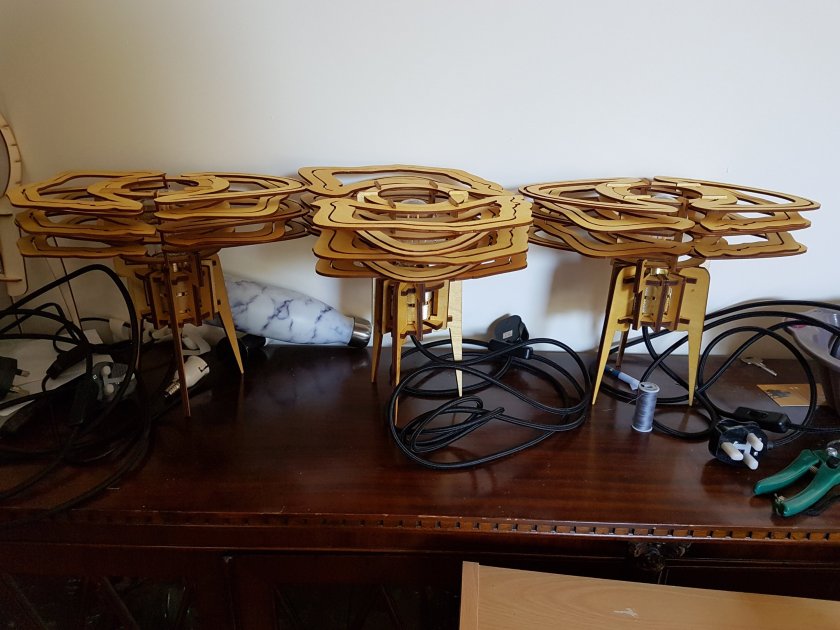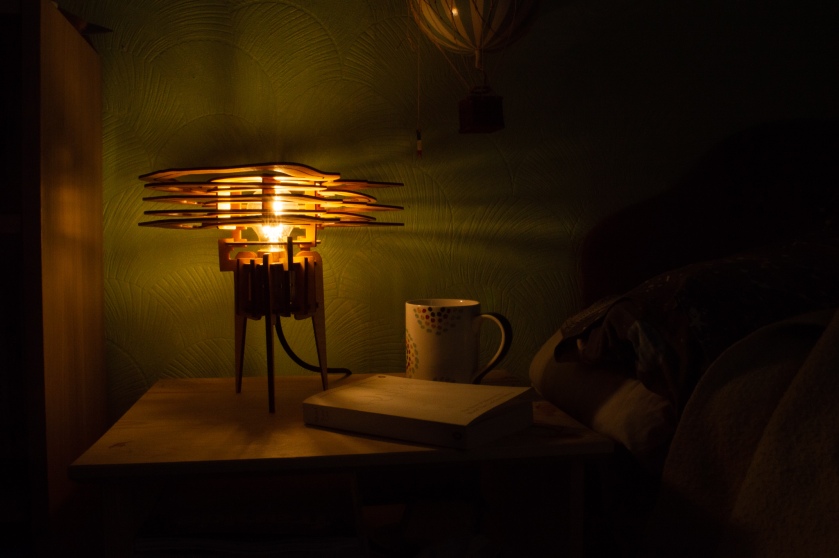Above left: Final lamps Above Right: Prototype lamp frame
Above are photos of my three finished lamps. I kept the design relatively unchanged from my previous iterations however there were a couple of modifications.
The first thing I did was to lower the height of the actual light diffusing part of the lampshade. I felt that on the model shown on the right there was too much space above the bulb and I thought it looked sort of awkward.
I also made three supporting slats instead of the original two so that the lampshade would have more support and would not rock around as much and would feel sturdier.
Finally I made the topological shapes wrap around the frame much more so that it would cover up the frame more and look more fitted and sweeping.
Not so much a design flaw as technical error on my part, the prototype model doesn’t fit together very well, the slots are slightly too big, causing the structure to be quite rickety and unstable. It is held together by super glue which, I probably don’t need to say, is not ideal. The final lamps have had this problem rectified and now fit together very well and have a much higher degree of structural integrity.
The ethos of the lamps are still very much the same, to create an item that is inspired by topology that can help people sleep that is also designed with sustainability in mind.
Sustainability has been a weird thing in this project, I have tried to keep it at the forefront of what I do because I find it so important as well as something that interests me generally. I think the problem is that it became a bit distracting in a sense and I think I got sidetracked becoming interested in alternative materials and forgot that actually creating a well made thing using planet friendly materials that is designed to last the course is an equally valid route in sustainability. I found making progress again much easier once I was able to shift my perspective from this hyper-awareness around what I was doing. After all it’s impossible to escape the fact that really the best thing to do is not to produce a product at all but that isn’t really a solution either and if people consumed responsibly wouldn’t necessarily have to be.
Below are photos of my lamp close up and in a domestic setting.
I am much happier with how these lamps turned out and I think the design adjustments I made have improved the lamp from previous iterations.
In addition to changing the height of the lamp, I have also forgone the use of wool to diffuse light. I had originally used wool because I was worried about how the light would be diffused and in hindsight I’m not convinced it was a particularly well considered choice and the implementation had been rushed and undeveloped. I think the problem was I had designed those lamps in such a way that it was hard for me not to feel that they needed a something. However some of them were an awkward shape that maybe didn’t lend themselves very well to that something.
The final version of my lamps have been developed but paired back in a way that speaks much more to my design sensibility than the previous lamps. The addition of wool in the previous lamps, even if I had done it in a way that was more sensitive to the materials (the wool) I was using, I think would have ended in something that maybe felt quite crafty and speaking of a soft and handmade approach. In so many words, I am trying to say that the connotations that wool carries as a material are not in alignment with what I would describe as being my ‘aesthetic’, so to speak.
When I had realised that I had strayed from what was making the lamp project interesting to me to start with, I knew that I needed to take it back to what I would feel confident to stand by and say this is what my design values are visually and philosophically speaking. With that in mind I would say that my design values are entrenched in bold, graphic shapes, a nod to 40s – 60s space age design, function and sustainability. By using just clean cut shapes as my form of light diffusion and leaving the edges of the plywood blackened, I think I was able to create a graphic, slightly space age, sustainability lead lamp.
I also believe that the alteration I made to the lamp structure and omitting the wool, I was able to design something that would have more value to a potential consumer. Wherein adding the wool made the product somewhat final, I realised that by changing the design to look finished without the need for an additional diffusion material, I could make the slats interchangeable, thus creating a further opportunity for customization. A customer can arrange the slats that come with the lamp as they please, whenever they want and could even order new slats and change the shape of their lamp altogether, thus creating new options for their lighting. I think this also opens up better avenues for sustainable practice.
Suppose a customer no longer wants their lamp for whatever reason. Rather than throw the whole thing away, perhaps the slats could be removed and the main body of the lamp is returned for reuse.
I think there are still some things I can see that I can tweak. I would, if doing this again, make room for a couple more supports for the top portion of the lamp or at least change the thickness of the wood. I don’t think it’s too precarious as is, but it would add a little more stability and strength to it.
I would also curve the slats just a little more as the top ones do butt up against the circles and stop the slats going fully in. The slat will still stay in place but it would be a slightly stronger joint otherwise.
Those are my thoughts on my final lamps.

















